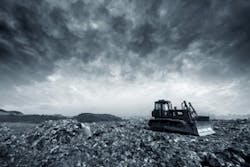Landfill Design and Operational Changes Curtail Odor Sources
As authors Daryl R. O’Dell and Matthew Beebe describe in Part 3 of this concluding series, odor-causing compounds in high concentrations—whether insufficiently controlled through landfill design or standard operations procedures—might require modifications to existing landfill design elements, installation of gas treatment systems, and changes to standard operating procedures in order to control extensive onsite odor generation. Of benefit to landfill managers and operators, our authors cite advanced solutions for managing odor-generating materials in the concluding segment of this series. Public health and worker safety concerns continue to drive this discussion.
And Then There Was Odor (Part 3) By Daryl R. O’Dell and Matthew Beebe
Odor. There, we said it! The four-letter word that can anger an entire community with a shift of the wind. This word haunts the dreams of many landfill managers.
When Landfill Gas Collection Is Not Enough
In most cases, sound engineering landfill design and good operational practices will successfully manage onsite and offsite odor, but when odorous compounds are present in high concentrations, a landfill gas treatment system may be warranted. The purchase, installation, and operation of such a system is a large expense, so landfill operators and landfill gas system design engineers must carefully consider a variety factors before determining the best system for a particular application. Landfill gas treatment is not a “one-size-fits-all” proposition.
Since hydrogen sulfide (H2S) is one of the primary odorous compounds of concern, we will focus on this compound for purposes of this discussion. The two largest contributing factors when determining which system is the best for an application are the H2S loading and the long term trend for H2S generation based on modeling and waste compositions. Other considerations are the required outlet gas concentration based on permit conditions or equipment needs, short and long term budgeting, personnel, and disposal of waste byproduct produced from treatment.
And Then There Was Odor (Part 3) By Daryl R. O’Dell and Matthew Beebe
Odor. There, we said it! The four-letter word that can anger an entire community with a shift of the wind. This word haunts the dreams of many landfill managers. When Landfill Gas Collection Is Not Enough In most cases, sound engineering landfill design and good operational practices will successfully manage onsite and offsite odor, but when odorous compounds are present in high concentrations, a landfill gas treatment system may be warranted. The purchase, installation, and operation of such a system is a large expense, so landfill operators and landfill gas system design engineers must carefully consider a variety factors before determining the best system for a particular application. Landfill gas treatment is not a “one-size-fits-all” proposition. Since hydrogen sulfide (H2S) is one of the primary odorous compounds of concern, we will focus on this compound for purposes of this discussion. The two largest contributing factors when determining which system is the best for an application are the H2S loading and the long term trend for H2S generation based on modeling and waste compositions. Other considerations are the required outlet gas concentration based on permit conditions or equipment needs, short and long term budgeting, personnel, and disposal of waste byproduct produced from treatment. [text_ad] Several technologies are available to remove H2S from extracted landfill gas. These landfill design technologies include solid scavenger, liquid reduction-oxidation, absorbers, filters, and biological systems. Solid scavenger systems are the best choice when a facility has a low H2S loading. Solid scavenger systems pass raw landfill gas saturated with water over a media bed where adsorption and biofiltration processes remove H2S from the gas stream. These systems are generally most cost effective for applications producing less than 150 pounds of H2S per day. The most common type of solid scavenger system is an “iron sponge,” which converts H2S to iron sulfide. These systems have been in use in various industries for over 100 years. No operators are needed and the systems typically have lower installation costs. In larger scale systems, media cost may be prohibitive. Spent media from a solid scavenger system is generally nonhazardous and can typically be disposed of in the landfill. The media fixes the extracted sulfur in a solid state and does not allow it to be released back into the landfill once it is disposed of. These systems can be expanded or contracted by adding or removing vessels as treatment needs change. The media changeout can be completed by local contractors; however media changeout can be messy and temporarily odoriferous. Also be aware that iron oxide can react with air and ignite, so additional care should be taken during change outs. Liquid reduction-oxidation (liquid-redox) systems are most cost effective for applications producing more than 150 pounds of hydrogen sulfide per day. These systems pass raw landfill gas through a catalyst solution in which H2S is converted to elemental sulfur and treated landfill gas exits the scrubber vessel. The catalyst is then regenerated using air and returned to the scrubber vessel. Sulfur is separated from the catalyst and removed from the system. Liquid-redox systems have several benefits for LFG applications, including lower operating costs at higher H2S removal rates, no media change-outs, and high efficiency (99% H2S removal). But these benefits come with high initial installation cost, sulfur disposal cost, and operational cost for electricity, chemicals, and operators. A high H2S loading in the landfill gas does not necessarily mean that a liquid-redox system is required. If a facility expects a high H2S loading in the short term, but the load will decrease due to in-situ treatment by reducing the intake of hydrogen sulfide producing waste and capping to limit stormwater entering the landfill, it may be more cost effective to use a solid scavenger system. This would require either sizing a larger system or more frequent media change outs, but as the system loading decreases, the economy of the system will increase. [text_ad] Other Systems Other systems used to control H2S include biological treatment, caustic scrubbers, and activated carbon. Activated carbon will also remove other volatile organic compounds because it is not a selective treatment system. The biological systems use thiobacillus bacteria, which are anaerobic, acidophilic (acid loving) bacteria that oxidize H2S. There are many systems available and each should be considered as you determine which one will serve your facility best. Carefully consider such aspects as treatable flow, H2S concentrations, installation and operations costs, and regulatory considerations before purchasing a system. Passing the Smell Test Readers of this article who design landfill and landfill gas control systems, or who deal with landfill operations in their day-to-day working lives have probably borne witness issues related to odor. Many of these situations require changes to landfill operations or landfill gas management systems when it becomes clear that initial landfill design did not consider the full spectrum of potential future considerations. We have seen that the investment required to control odor in advance is relatively small compared to installing expensive treatment systems after the fact. While it can be difficult to anticipate the full future effect of an initial design, proper planning will aid in avoiding rework or repair, saving money, and ultimately providing the best service to the community. Ultimately, when odor-producing compounds begin emanating from a waste facility, additional effort and engineered controls must be implemented. While multiple approaches to successful odor management can be used, a proactive approach to odor control will provide greater peace of mind than a reactive approach. And, while none of us can claim to be clairvoyant, a few bad experiences coupled with known industry and regulatory trends show us that applying good knowledge and experience will pay off in the end.Several technologies are available to remove H2S from extracted landfill gas. These landfill design technologies include solid scavenger, liquid reduction-oxidation, absorbers, filters, and biological systems.
Solid scavenger systems are the best choice when a facility has a low H2S loading.
Solid scavenger systems pass raw landfill gas saturated with water over a media bed where adsorption and biofiltration processes remove H2S from the gas stream. These systems are generally most cost effective for applications producing less than 150 pounds of H2S per day. The most common type of solid scavenger system is an “iron sponge,” which converts H2S to iron sulfide. These systems have been in use in various industries for over 100 years. No operators are needed and the systems typically have lower installation costs. In larger scale systems, media cost may be prohibitive.
Spent media from a solid scavenger system is generally nonhazardous and can typically be disposed of in the landfill. The media fixes the extracted sulfur in a solid state and does not allow it to be released back into the landfill once it is disposed of. These systems can be expanded or contracted by adding or removing vessels as treatment needs change.
The media changeout can be completed by local contractors; however media changeout can be messy and temporarily odoriferous. Also be aware that iron oxide can react with air and ignite, so additional care should be taken during change outs. Liquid reduction-oxidation (liquid-redox) systems are most cost effective for applications producing more than 150 pounds of hydrogen sulfide per day.
These systems pass raw landfill gas through a catalyst solution in which H2S is converted to elemental sulfur and treated landfill gas exits the scrubber vessel. The catalyst is then regenerated using air and returned to the scrubber vessel. Sulfur is separated from the catalyst and removed from the system.
Liquid-redox systems have several benefits for LFG applications, including lower operating costs at higher H2S removal rates, no media change-outs, and high efficiency (99% H2S removal). But these benefits come with high initial installation cost, sulfur disposal cost, and operational cost for electricity, chemicals, and operators.
A high H2S loading in the landfill gas does not necessarily mean that a liquid-redox system is required. If a facility expects a high H2S loading in the short term, but the load will decrease due to in-situ treatment by reducing the intake of hydrogen sulfide producing waste and capping to limit stormwater entering the landfill, it may be more cost effective to use a solid scavenger system. This would require either sizing a larger system or more frequent media change outs, but as the system loading decreases, the economy of the system will increase.
And Then There Was Odor (Part 3) By Daryl R. O’Dell and Matthew Beebe
Odor. There, we said it! The four-letter word that can anger an entire community with a shift of the wind. This word haunts the dreams of many landfill managers. When Landfill Gas Collection Is Not Enough In most cases, sound engineering landfill design and good operational practices will successfully manage onsite and offsite odor, but when odorous compounds are present in high concentrations, a landfill gas treatment system may be warranted. The purchase, installation, and operation of such a system is a large expense, so landfill operators and landfill gas system design engineers must carefully consider a variety factors before determining the best system for a particular application. Landfill gas treatment is not a “one-size-fits-all” proposition. Since hydrogen sulfide (H2S) is one of the primary odorous compounds of concern, we will focus on this compound for purposes of this discussion. The two largest contributing factors when determining which system is the best for an application are the H2S loading and the long term trend for H2S generation based on modeling and waste compositions. Other considerations are the required outlet gas concentration based on permit conditions or equipment needs, short and long term budgeting, personnel, and disposal of waste byproduct produced from treatment. [text_ad] Several technologies are available to remove H2S from extracted landfill gas. These landfill design technologies include solid scavenger, liquid reduction-oxidation, absorbers, filters, and biological systems. Solid scavenger systems are the best choice when a facility has a low H2S loading. Solid scavenger systems pass raw landfill gas saturated with water over a media bed where adsorption and biofiltration processes remove H2S from the gas stream. These systems are generally most cost effective for applications producing less than 150 pounds of H2S per day. The most common type of solid scavenger system is an “iron sponge,” which converts H2S to iron sulfide. These systems have been in use in various industries for over 100 years. No operators are needed and the systems typically have lower installation costs. In larger scale systems, media cost may be prohibitive. Spent media from a solid scavenger system is generally nonhazardous and can typically be disposed of in the landfill. The media fixes the extracted sulfur in a solid state and does not allow it to be released back into the landfill once it is disposed of. These systems can be expanded or contracted by adding or removing vessels as treatment needs change. The media changeout can be completed by local contractors; however media changeout can be messy and temporarily odoriferous. Also be aware that iron oxide can react with air and ignite, so additional care should be taken during change outs. Liquid reduction-oxidation (liquid-redox) systems are most cost effective for applications producing more than 150 pounds of hydrogen sulfide per day. These systems pass raw landfill gas through a catalyst solution in which H2S is converted to elemental sulfur and treated landfill gas exits the scrubber vessel. The catalyst is then regenerated using air and returned to the scrubber vessel. Sulfur is separated from the catalyst and removed from the system. Liquid-redox systems have several benefits for LFG applications, including lower operating costs at higher H2S removal rates, no media change-outs, and high efficiency (99% H2S removal). But these benefits come with high initial installation cost, sulfur disposal cost, and operational cost for electricity, chemicals, and operators. A high H2S loading in the landfill gas does not necessarily mean that a liquid-redox system is required. If a facility expects a high H2S loading in the short term, but the load will decrease due to in-situ treatment by reducing the intake of hydrogen sulfide producing waste and capping to limit stormwater entering the landfill, it may be more cost effective to use a solid scavenger system. This would require either sizing a larger system or more frequent media change outs, but as the system loading decreases, the economy of the system will increase. [text_ad] Other Systems Other systems used to control H2S include biological treatment, caustic scrubbers, and activated carbon. Activated carbon will also remove other volatile organic compounds because it is not a selective treatment system. The biological systems use thiobacillus bacteria, which are anaerobic, acidophilic (acid loving) bacteria that oxidize H2S. There are many systems available and each should be considered as you determine which one will serve your facility best. Carefully consider such aspects as treatable flow, H2S concentrations, installation and operations costs, and regulatory considerations before purchasing a system. Passing the Smell Test Readers of this article who design landfill and landfill gas control systems, or who deal with landfill operations in their day-to-day working lives have probably borne witness issues related to odor. Many of these situations require changes to landfill operations or landfill gas management systems when it becomes clear that initial landfill design did not consider the full spectrum of potential future considerations. We have seen that the investment required to control odor in advance is relatively small compared to installing expensive treatment systems after the fact. While it can be difficult to anticipate the full future effect of an initial design, proper planning will aid in avoiding rework or repair, saving money, and ultimately providing the best service to the community. Ultimately, when odor-producing compounds begin emanating from a waste facility, additional effort and engineered controls must be implemented. While multiple approaches to successful odor management can be used, a proactive approach to odor control will provide greater peace of mind than a reactive approach. And, while none of us can claim to be clairvoyant, a few bad experiences coupled with known industry and regulatory trends show us that applying good knowledge and experience will pay off in the end.Other Systems
Other systems used to control H2S include biological treatment, caustic scrubbers, and activated carbon. Activated carbon will also remove other volatile organic compounds because it is not a selective treatment system. The biological systems use thiobacillus bacteria, which are anaerobic, acidophilic (acid loving) bacteria that oxidize H2S.
There are many systems available and each should be considered as you determine which one will serve your facility best. Carefully consider such aspects as treatable flow, H2S concentrations, installation and operations costs, and regulatory considerations before purchasing a system.
Passing the Smell Test
Readers of this article who design landfill and landfill gas control systems, or who deal with landfill operations in their day-to-day working lives have probably borne witness issues related to odor. Many of these situations require changes to landfill operations or landfill gas management systems when it becomes clear that initial landfill design did not consider the full spectrum of potential future considerations. We have seen that the investment required to control odor in advance is relatively small compared to installing expensive treatment systems after the fact. While it can be difficult to anticipate the full future effect of an initial design, proper planning will aid in avoiding rework or repair, saving money, and ultimately providing the best service to the community.
Ultimately, when odor-producing compounds begin emanating from a waste facility, additional effort and engineered controls must be implemented. While multiple approaches to successful odor management can be used, a proactive approach to odor control will provide greater peace of mind than a reactive approach. And, while none of us can claim to be clairvoyant, a few bad experiences coupled with known industry and regulatory trends show us that applying good knowledge and experience will pay off in the end.
About the Author
Daryl R. O’Dell and Matthew Beebe
Matthew Beebe, E.I.T., is a Project Engineer with Cornerstone Environmental Group.


